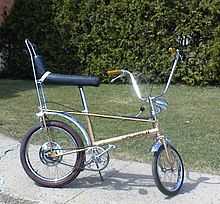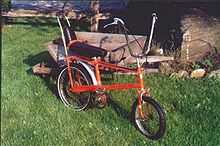Raleigh Chopper

This example is missing the rear seat springs and the chain guard.
The Raleigh Chopper is a children's bicycle, a wheelie bike, manufactured and marketed in the 1970s by the Raleigh Bicycle Company of Nottingham, England. Its unique design became a cultural icon, and is fondly remembered by many who grew up in that period. Based on the look of a customised chopper motorcycle, made popular with films such as Easy Rider,[1][2] the Chopper bike was the "must have" item and signifier of "coolness"[3] for many children at the time.[4][5]
Design

Ogle Design claim to have designed the Chopper for Raleigh. They actually only produced concept art for the Raleigh design department headed by Alan Oakley; only the seat and spoke protector were taken up. The final design of the Chopper was submitted by Oakley's department to management and production started in 1968.[6] Raleigh built a copy of the chopper-like Schwinn Sting-Ray they called the Rodeo, which was launched in the United States in 1966. It was not a success, but its design clearly was a forerunner of the Chopper.[citation needed] This lack of success prompted Raleigh to send its chief designer, Alan Oakley, to America to investigate first hand the United States youth market. Oakley saw that a new bike was required, in a very non-Schwinn style. On the flight home Oakley penciled the first outlines of what would become the Chopper onto the back of an airmail envelope.[7]
The popularity of the Chopper also led to a range of smaller bikes following a similar design theme. These included the Raleigh Chipper, Tomahawk, Budgie and Chippy models, aimed at younger riders.[8]
History

Original Chopper — tall frame 1969 1/2
The Chopper was patented in the UK in 1967 and patented in the US in 1968. The Chopper was introduced at American trade shows in January 1969, and first shipments of Choppers were Fastback 100's delivered to the Eaton's department store chain in Canada in April 1969. It was not till June 69 (June 1/2) that Raleigh Choppers are released . The bike featured a choice of a single-speed hub, or a 3-speed or 5-speed Sturmey Archer gear hub, selected using a frame-mounted console gear lever — one of its "cool" features. Other features that appealed to the youth market were the unusual frame, long padded highback seat, sprung seat at the back, high-rise (ape hanger) handlebars, 'bobbed' mudguards (fenders) and differently sized wheels — 16 in (41 cm) front and 20 in (51 cm) rear. The rear hoop above the seat resembled a motorcycle "sissy bar". Even the kickstand was designed to give the stationary bicycle a lean reminiscent of a parked motorcycle.[9] Tyres were wider than usual for the time, with a chunky tread on the rear wheel, featuring a red line around the sidewall. The price was from approximately £32 for a standard Chopper to £55 for the deluxe.
Fastback 100
The Raleigh Chopper was sold through Eatons of Canada variously as a Glider Fastback 100, Fastback XT101, Fastback Princess, Fastback SS357 and MACH-2 models.
Mk 2
The Mk 2 ("Mark 2") Chopper was an improved version from 1972. It had the rarely purchased option of five-speed derailleur gears, and the gear lever shifter changed from a knob to a T-bar-style shifter. The frame was subtly revised, and the seat moved forward, to help prevent the front of the bicycle tipping up. A small rear rack was added. The handlebars were welded to the stem to stop children from inclining the "ape hanger" bars backward, thereby rendering the bicycle almost unsteerable. A drop-handlebar version, the Sprint, was also produced, this differed from the standard Mk 2, as it had a slightly taller frame. The Chopper remained in production until 1981, by which time the BMX craze had taken over its market.[10] However, the Chopper almost single-handedly rescued Raleigh, which had been in decline during the 1960s, selling millions worldwide.
Handling and safety
The original Chopper is fondly remembered, though it was not without problems: It was less stable than a conventional bicycle, and trickier to ride. It was slow and heavy, the wide tires creating significant rolling resistance; the Chopper was not suitable for long distances. At moderate speeds it suffered speed wobbles.[11] After several reported accidents, it was attacked in the press as a dangerous toy. The long seat lent itself to giving lifts to others,[12] and accidents were not uncommon. It could perform involuntary wheelies readily, again a frequent cause of accidents. The position of the gear lever could also contribute to injuries sustained in a crash.
Original models
- Mark I Tall Frame; available as single speed, 3 speed and 5 speed.
- Mark I; available as a single speed, 3 speed, 5 speed and 10 speed.
- Mark I Girly; available as single speed and 3 speed.
- Mark II; available as a 3 speed and 5 speed.
- Mark II Chopper Sprint; available as 3 speed.
- Mark II Special Edition SE
Imitators
The runaway success of the Chopper led to many similarly styled imitators, such as the Pavemaster Trusty Tracker and Vindec High Riser in the UK as well as the very close copy of an Mk 2 named "Chincoa" and Ground Cruiser, although this is more a mix of all three models sporting a single top tube between the saddle and head tube.
Revival: Mk 3
A new version of the Chopper, the Mk 3, was launched in 2004, after being out of production for almost 25 years. The Mk3, in deference to modern safety concerns, adopts a more conventional saddle design to discourage "backies", and has dropped the groin-catching gear lever in favour of handlebar mounted gear controls; to commemorate this former feature the Mk 3 has a sticker where the lever once was. The frame is made from aluminium alloy tubing, rather than the originals' steel, to make the bicycle lighter. The wheels are again 20 inches for the back wheel and 16 for the front wheel.[7]
See also
References
- ↑ David McKittrick (2012-05-26). "Alan Oakley: Designer whose Raleigh Chopper bike was a defining image of the 1970s". The Independent. Retrieved 2012-08-11. "According to Gary Hughes, who runs the Raleigh Chopper Owners' Club: "It's the whole thing of the dragsters, the actual shape of the bike, the big wheel. The Easy Rider film – it was the next best thing to that Harley-Davidson bike that Peter Fonda used to ride.""
- ↑ "Raleigh Chopper". RetroWow. Retrieved 2009-01-27.
- ↑ "http://bikehugger.com/2007/06/raleigh_chopper_bicycle.htm". Bike Hugger. 2007-06-18. Retrieved 2009-01-27.
- ↑ Finlo, Finlo (2004-01-15). "Design classic that entranced kids". BBC News Online. Retrieved 2009-01-27.
- ↑ "Raleigh Chopper". DoYouRemember Ltd. Retrieved 2009-01-27.
- ↑ "I designed the Chopper, argues Cambridge inventor". Bike Biz. Retrieved March 2, 2006.
- ↑ 7.0 7.1 "Raleigh Chopper designer Alan Oakley dies from cancer". BBC. 20 May 2012. Retrieved 20 May 2012.
- ↑ "Chopper Extreme". Chopper Extreme. Archived from the original on 2006-10-13.
- ↑ "Raleigh Chopper — Cooper Mk.1". RaleighChopper.info. Retrieved 2009-01-27.
- ↑ Kirby, Terry (2004-02-26). "The decade taste forgot is back — on a brand new Raleigh Chopper". London: The Independent. Retrieved 2009-01-27.
- ↑ PERROTT, ALAN (2004-04-10). "Cool Chopper hits road again". The New Zealand Herald. Retrieved 2009-01-27.
- ↑ "The Raleigh Chopper". everythingbicycling. Retrieved 2009-01-27.
External links
- The Chopper Clubs official Forum
- Information about Choppers
- RaleighChopper.info — Specification sheets, maintenance manuals and more
- Production timeline at the BBC
| |||||||||||||||||||||||||||||||||||||||||||